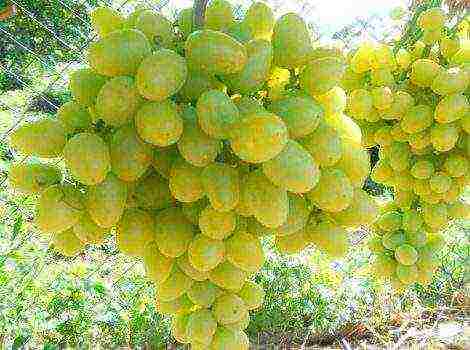Content [show]

Let's talk about cherries and describe the best varieties of it. There are sweet, slightly sour, crispy, soft, different colors. Thanks to selection, every year new forms of this amazing tree are bred.
Content:
Cherry varieties: description and photo
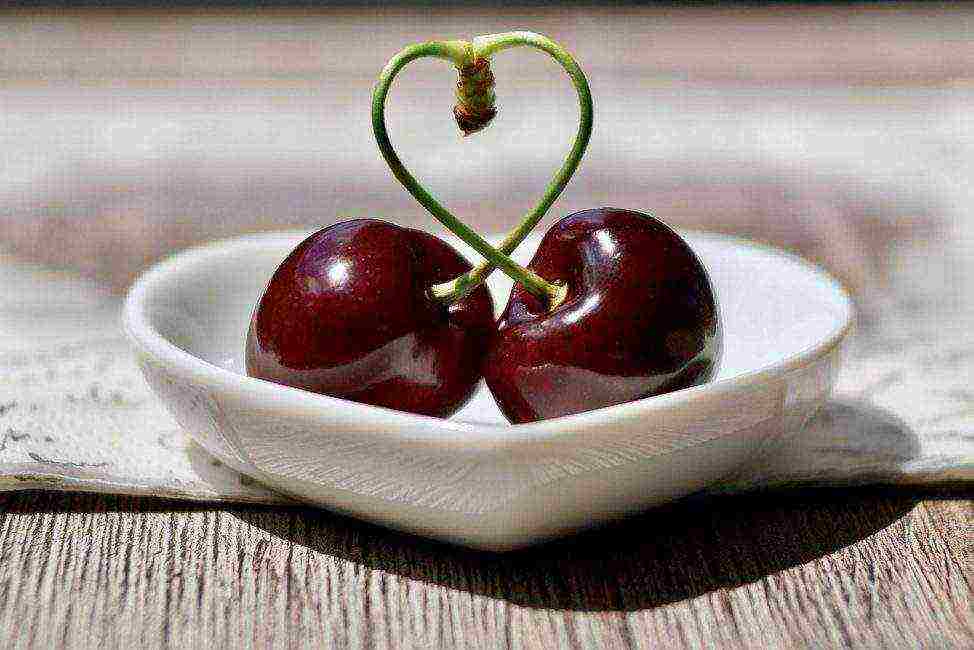
To get a bountiful harvest, it is necessary to choose varieties taking into account the peculiarities of the climate in a particular region. So, frost-resistant varieties are suitable for central Russia, and more thermophilic plants can be grown in Ukraine.
Unlike cherry, sweet cherry ripens much earlier, its tasty and aromatic fruits can already be enjoyed in early summer - June. It is a real source of useful trace elements (iron, iodine, potassium, magnesium, calcium) The fruits of the plant grow in the form of a single-celled drupe with a juicy pericarp.
Considering the late period of emergence of cherry fruit buds from the state of forced dormancy, the yield of this crop is characterized as stable. Another advantage of cherries is the presence of reliable protection from return frost in anthers and pistils, which is not the case with cherries.
The leaves of the fruit crop are very large in size, they are distinguished by an elongated-oval or elongated-obovate shape and brown glands on the petioles.
Most of the cherry varieties require additional pollination. Therefore, when choosing a tree, it is recommended to study its description, which indicates the necessary pollinators.
It is not so often possible to find self-fertile varieties on the market. They can be purchased by order from abroad. Among the popular hybrid forms, there are: Alex, Peter, Stella, Sandor, Sweet Hart.
Below is a list of the most popular cherry varieties with descriptions and photos.
back to menu ↑ Iput
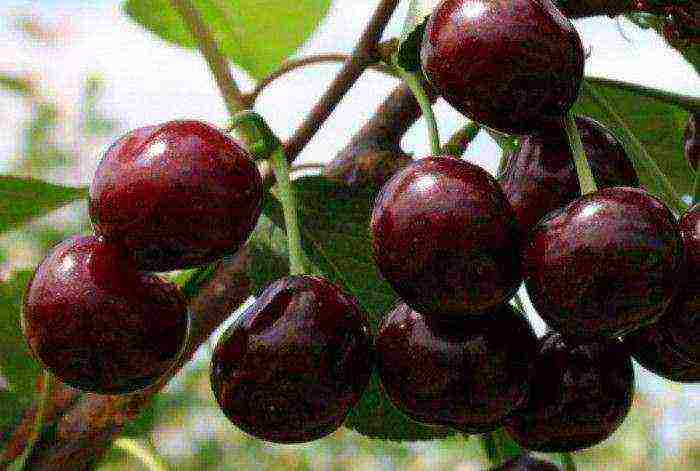
PROS:
- Average height
- Early ripening of fruits
- High yield (up to 30 kg of berries are removed from one tree)
- High palatability (fruits have black color and dark red juicy pulp)
- The berry is removed with the stalk
- The crop is not afraid of transportation
- High degree of resistance to fungal infections
- It tolerates low temperatures well (up to -28 degrees)
MINUSES:
- Average early maturity (yields a harvest 5 years after planting)
- With an excess of moisture, the fruits crack
- The pulp is difficult to separate from the bone
According to reviews:
It is recommended to plant it in pairs together with Revna, since these varieties are inter-pollinated. It turned out to be very tasty, large, the first harvest is already 3 years old. It grows quickly, almost one meter increments per year. turned out to be not dark red, but just red, maybe because of the lack of the sun.
back to menu ↑ Valery Chkalov
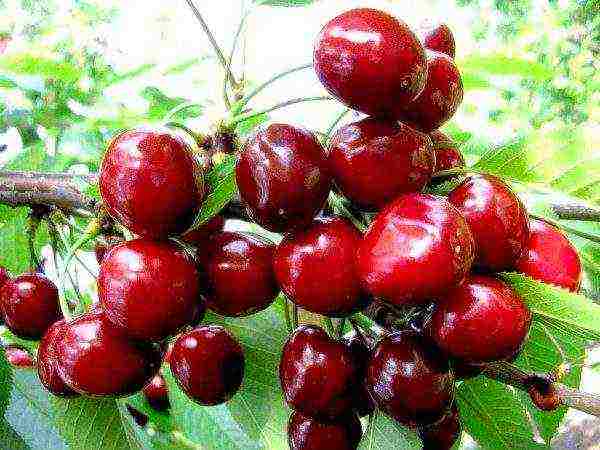
PROS:
- Early ripening of berries
- Large fruit size (weight up to 6-8 g)
- High taste characteristics of fruits (the pulp is dark red in color, juicy, semi-gristly consistency)
- Dessert type
- Universal use of berries
- High level of productivity (62 kg per tree on average)
- High level of frost resistance (-23.5 degrees
MINUSES:
- Height (up to 5 m)
- Wet separation of the berry from the stalk, juice is released
- The level of early maturity is medium (yields a harvest for 5 years)
- Self-infertile variety
- Average level of resistance to diseases, including fungal
Pollinators: Dnieper, Bigarro Burlat, April, June early Skorospelka
back to menu ↑ Revna

PROS:
- Medium-sized tree, compact
- The crown has no sharp forks
- Unpretentious in care
- Fruits are distinguished by high taste and consumer qualities.
- Due to the dense skin, the crop is transportable over long distances
- High level of frost resistance (up to -30 degrees)
- High resistance to frost crack, sunburn
- Resistance of the tree to fungal infections
MINUSES:
- Medium late harvest ripening
- Self-infertility
Its best pollinators: Raditsy, Compact, Iput, Venyaminova, Tyutchevka, Ovstuzhenki
back to menu ↑ Large-fruited
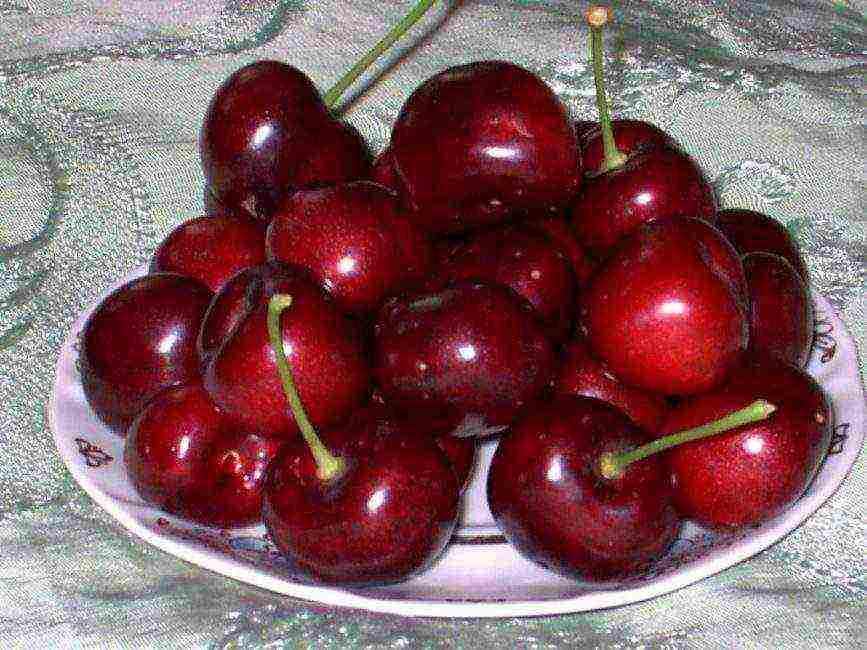
PROS:
- Medium-sized tree
- Fruits are very large in size, their weight is up to 18 g
- Sweet and sour taste, dark red fruit color, medium density pulp
- High product characteristics
- Increased frost resistance
- Dry detachment of the peduncle
- Good transportability
- Not susceptible to moniliosis
- Drought tolerance, no loss of crop flavor
MINUSES:
- Late ripening
- Self-sterile
Top pollinators: Bugaro Oratovsky, Surprise, Francis,
back to menu ↑ Vasilisa
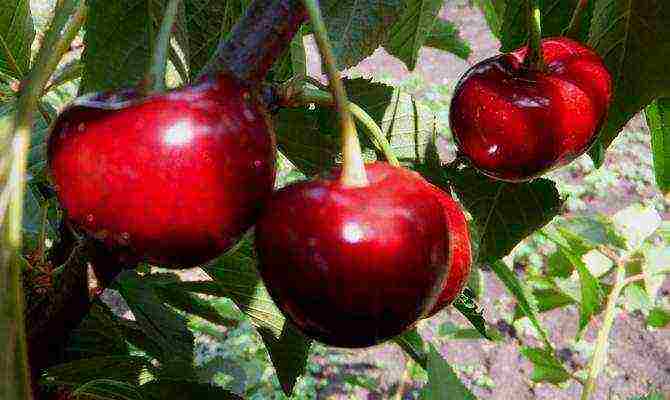
PROS:
- Mid-season
- Very large berries, weighing up to 15 g
- Taste and commercial qualities are excellent (the fruits have a rich red color, glossy shine, the pulp is dense, fleshy, juicy)
- Tasting score 4.5 points
- Duration of fruiting 20 years
MINUSES:
- Berries with heavy precipitation are subject to shedding
- Requires additional pollination
- Low resistance to fungal diseases and garden pests
Top pollinators: Early ripening, Burlat, April, Household, Early Bigarro
back to menu ↑ Ovstuzhenka
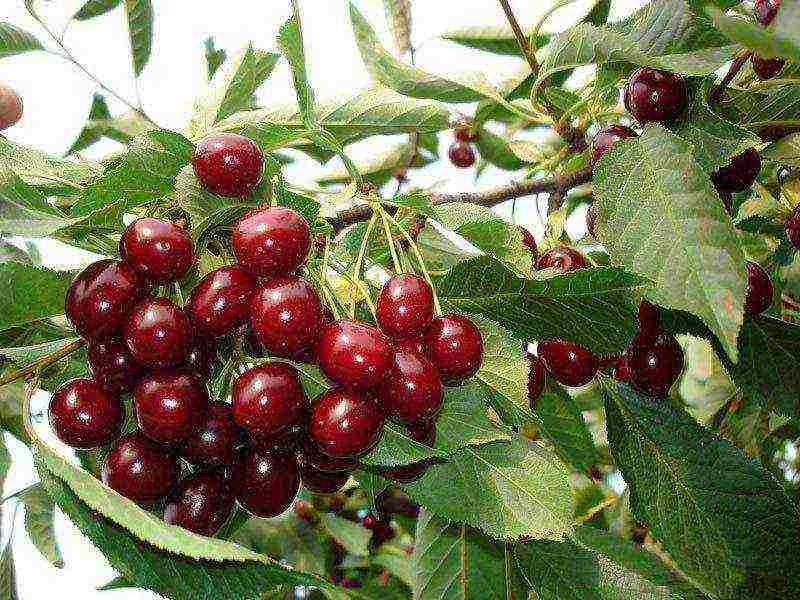
PROS:
- Early ripening of the crop
- It does not require special care
- Medium-sized tree, with a rapid growth rate
- Large berries, weight up to 7 g
- The pulp is sweet enough, juicy
- The color of the berries is dark burgundy
- Product and taste characteristics are high
- Disease resistance is good
- High frost resistance
MINUSES:
- Average yield, on average 15 kg per tree
back to menu ↑ Regina
PROS:
- Late-ripening variety
- The size of the tree is medium, the growth is gradual
- Does not create difficulties in care and harvesting
- High indicator of presentation and taste
- Berries are not afraid of transportation
- The structure of the berries is firm, the pulp is tasty and aromatic
- The size of the fruits is large, their weight reaches 10 g
- The level of frost resistance is sufficient
- Disease resistance to garden pests is excellent
MINUSES:
- Low rate of resistance to viral diseases
- Requires additional pollination
Pollinators: Karina, Bianca, Sylvia, Nephris, Coral Lotivka
back to menu ↑ Bull heart
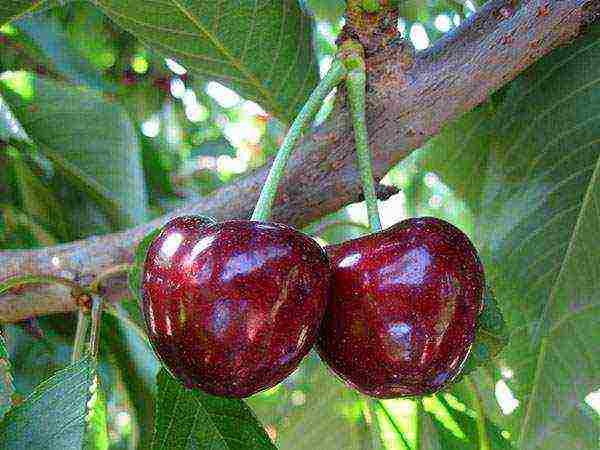
PROS:
- Large-fruited, average berry size 8 g
- The color of the fruit is dark burgundy, the pulp is medium density, the skin is moderately dense with a smooth surface
- Type of separation from the stalk dry
- Universal purpose of fruits
- High degree of productivity
- The size of the tree is medium, but there are also tall plants.
- The degree of frost resistance is good, up to - 25 degrees
- Not susceptible to coccomycosis
MINUSES:
- Low transport rate despite dense skin
- Berries have a short shelf life, processing is required as soon as possible
- Self-infertile variety
Top pollinators: Tyutchevka, Iput, Ovstuzhenka
back to menu ↑ Yellow
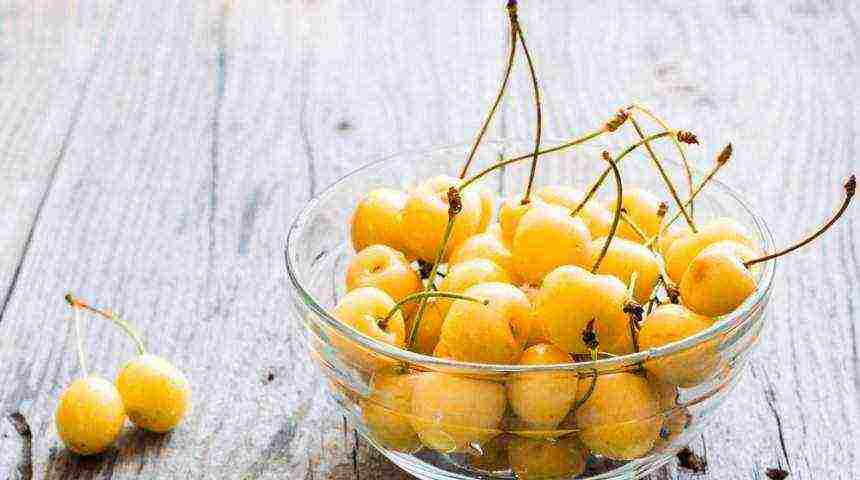
PROS:
- Late ripening of berries
- Increased winter hardiness
- Excellent taste (the pulp is amber, dense structure, juiciness and pronounced aroma)
MINUSES:
- The degree of transportability is low
- The pulp does not separate well from the bone
- Additional pollination required
- Exposed to the invasion of the cherry fly
Pollinators: Bagration, Napoleon pink. Denissena yellow, Cassini early
back to menu ↑ Early pink
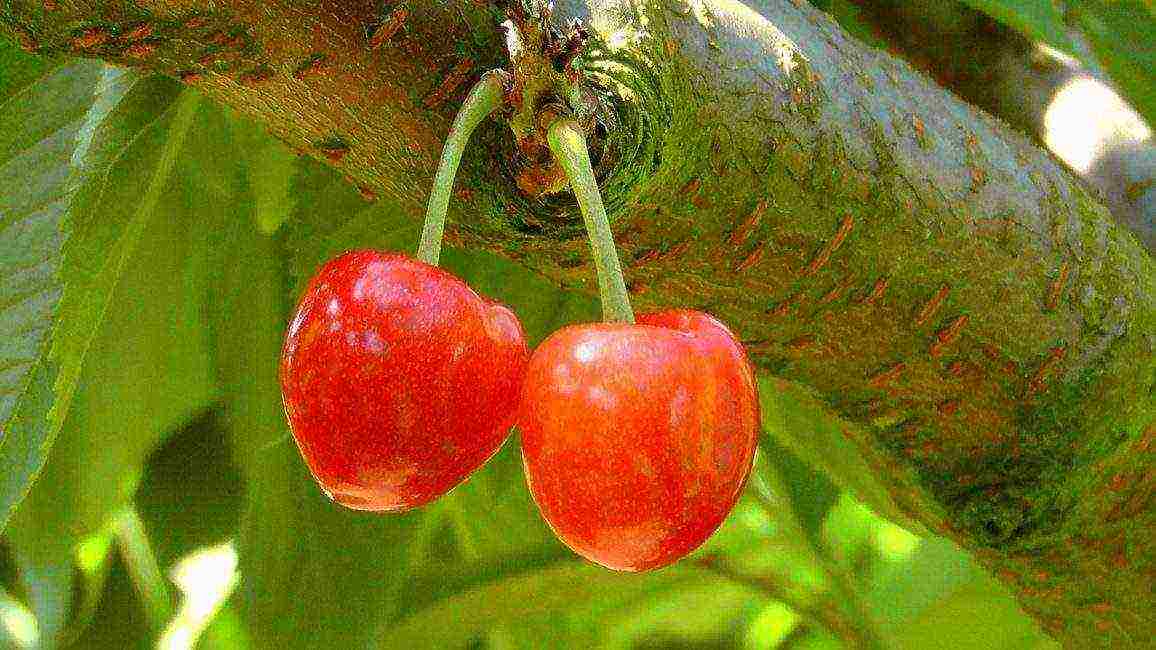
PROS:
- Early ripeness of fruits
- Taste characteristics are high (the pulp is distinguished by a creamy color, the structure is medium-dense, the juice is transparent)
- High resistance to low temperatures
- A fairly good level of resistance to monoliosis, coccomycosis
- Dessert type of berries
- High yield rate, up to 40 kg per tree on average
MINUSES:
- Berries are medium in size, their weight reaches an average of 5 g
- Trees grow up to 5 m
- Low rate of crop transportability
- Poor keeping quality of berries, processing is required in a short time after full ripening
back to menu ↑ Fatezh

PROS:
- Large-fruited, their average weight is 4.5 g, maximum 6 g
- Fruit tasting score 4.7 points
- The pulp separates easily from the bone
- Fruiting begins at 3-4 years of life of the tree
- The yield indicator reaches 50 kg per tree per season
- The level of winter hardiness is high -30 degrees
- Not susceptible to fungal infections, coccomycosis, moniliosis
- Berries are not afraid of long distance transportation
MINUSES:
- Additional pollination required
Recommended pollinators: Chermashnaya, Iput, Revna, Crimean, Raditsa.
back to menu ↑ Leningradskaya black
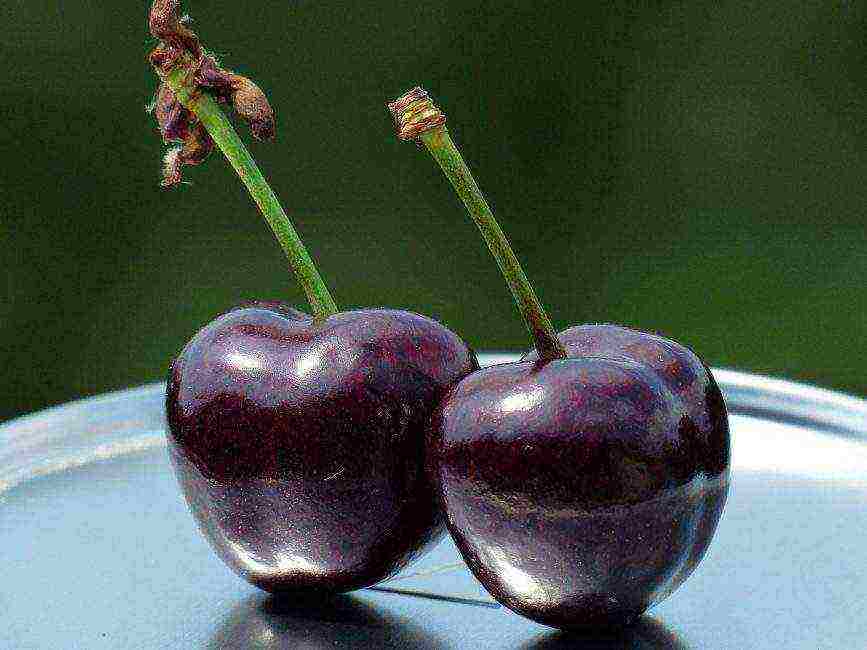
PROS:
- The variety is medium-sized, spreading crown
- The first crop can be harvested in the third year after planting in a permanent place, in June
- Tasting assessment of the harvest 4.2 points
- The taste and market characteristics are high (the average weight of berries is 5 g, the color is dark burgundy, the pulp is sweet, juicy, there is a slight bitterness)
- The purpose of the fruits is universal, excellent for fresh consumption, and for compotes, jam
- High rate of resistance to garden pests and various diseases
- The variety is unpretentious in care
- The increased degree of frost resistance, withstands low temperatures up to -30 degrees
MINUSES:
- Self-fertile variety
- Additional pollination required
Pollinators required: Leningrad yellow, Leningrad pink, Red dense, Fatezh Berries are prone to cracking, with excessive moisture.
back to menu ↑ Dyber black
PROS:
- High level of productivity, most often up to 90 kg of tasty and aromatic berries are removed from trees, but under favorable conditions, 170 kg of harvest can be removed from one tree
- Fruits are large in size, their average weight is 6 g
- The pulp is of medium density, juiciness, dark burgundy color, there is a slight sourness
- The frost resistance index is quite high, up to -30 degrees
MINUSES:
- Poor resistance to negative temperatures
- Mature trees reach a height of almost 6 m, which makes them difficult to care for and harvest
- The tree begins to bear fruit 5 years after planting in a permanent place
- Requires additional pollination
- Insufficient immunity to various types of diseases, including fungal, to garden pests
- Regular pruning of the crown is required
Recommended pollinators: Drogana yellow, Bull heart, Napoleon pink, Fatezh,
back to menu ↑ Cordia
PROS:
- "Queen" of late varieties
- Universal fruits
- Taste and commercial characteristics are high
- Berries are large enough, their weight can reach 8-10 g
- Color carmine black, skin tone bronze
- Fruits are not prone to cracking, do not rot
- Excellent long-distance transportation
- When grown on vigorous rootstocks, the variety is characterized by rapid growth.
- Productivity is regular, fairly high
MINUSES:
- The variety is self-fertile, additional pollination is required
- There is a need for short pruning, the growth of shoots is significantly enhanced
- Average winter hardiness
- The crop is moderately resistant to cracking
Top pollinators: Van, Summit, Karina, Regina, Burlat.
back to menu ↑ Tyutchevka
PROS:
- Medium late harvest ripening
- Medium-sized tree, semi-spreading crown, sparse, spherical
- The beginning of the fruiting period falls on 3-4 years of plant life.
- The berries are medium in size, their weight is 5-6 g, but under favorable growing conditions they can reach 7 g
- Taste and commercial characteristics are excellent (the color of the pulp is dark red, the structure is dense, the aroma is pronounced)
- Tasting assessment of the harvest 4.9 points
- The crop is not afraid of transportation over long distances, the keeping quality of the fruits is good
- Resistance to major diseases is good
- The average productivity index is over 97 c / ha, with proper agricultural technology this indicator can reach 275 c / ha
- High level of resistance to moniliosis
MINUSES:
- Low self-pollination rate, up to 6%
- Average degree of resistance to clasterosporium disease, coccomycosis
Top pollinators: Iput, Raditsa, Revna, Ovstuzhenka
back to menu ↑ Generalskaya
PROS:
- Variety with medium-late ripening of berries
- The size of the fruits is large enough, their weight is 9-12 g
- The color is yellow, there is a carmine blush
- The pulp stands out with a sweet and sour taste, dense structure, very juicy
- Tasting score - 4.6 points
- The indicator of drought resistance and frost resistance is very high
- Fruiting begins 3 years after planting in a permanent place
- Unpretentiousness when growing
- Resistance to typical diseases and garden pests is sufficient
MINUSES:
- Fruits cannot retain their taste and marketability for a long time, they do not tolerate long-distance transportation
Pollinators: Tyutchevka, Ovstuzhenka, Iput, Crimean, Lapins
back to menu ↑ Italian
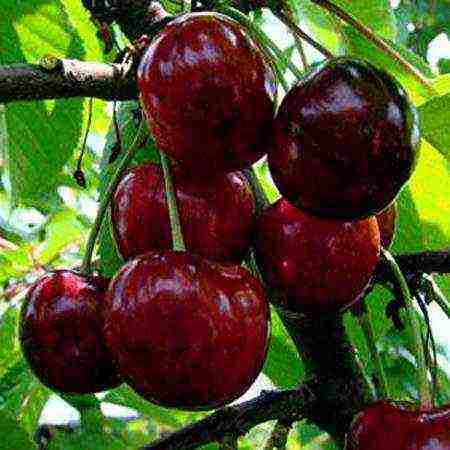
PROS:
- Self-fertile variety
- Fruits ripen early
- Taste and marketable qualities are excellent (the color of the berries is deep red, the pulp is moderately dense, tender, fleshy, it separates well from the stone)
- Large fruits, weight up to 6 g
- High productivity index
- Resistance to major diseases and garden pests is high
- Good frost resistance, up to - 28 degrees
MINUSES:
- There are no obvious shortcomings, based on the reviews of gardeners
back to menu ↑ Bakhor

PROS:
- The crop ripens early, in the first - in the second decade of May
- The tree grows very quickly, the degree of leafiness is medium, the crown is round
- Fruiting period begins in the fourth year after planting in a permanent place.
- The size of the fruits is quite large, 8-9 g, their color is dark red, wide-heart shaped
- The color of the pulp is dark red, the structure is medium density, very juicy, it has a sweet taste, there is a slight sourness
- The pulp separates well from the stone
- Due to the dense skin, the crop is not afraid of transportation over long distances, it retains its presentation for a long time
- The fruits can be used both for fresh use and for compotes, jams, preserves.
- Tasting score 5 points
- Dessert type harvest
- Planting material is grown from seedlings
- The indicator of resistance to fungal diseases is good
- Frost resistance is sufficient, up to - 25 degrees
MINUSES:
- Vigorous, height 5-6 m
- The yield indicator is average, up to 45 kg of fruits can be removed from one tree
back to menu ↑ Farewell
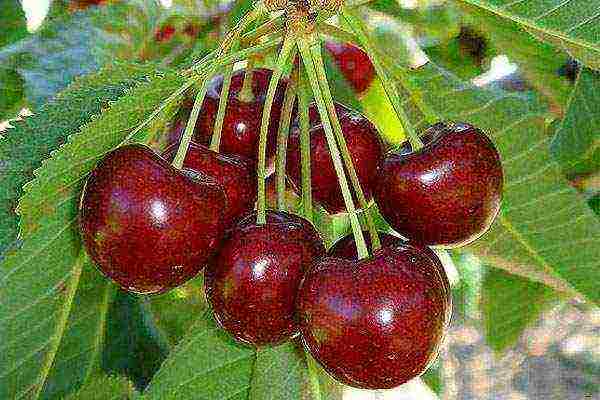
PROS:
- Cherries with early ripening, are very popular among gardeners and consumers.
- It is appreciated for its unpretentious care.
- Excellent taste of fruits, large-fruited, high rate of drought and winter hardiness
- High yield rate, up to 95 kg of harvest is removed from one tree
- Fruits are excellent for fresh use, for winter harvesting
- The size of the berries is large enough, weight up to 13 g
- The color is red, the color of the flesh is yellow
- The taste is sweet, harmonious, the aroma is pronounced, there is a wine-sweet aftertaste
- The pulp is easily separated from the bone
- The tasting score is 4.5 points
- The variety is distinguished by its early maturity
- The yield is high, after 10 years the figure is about 100 kg
- Thanks to the dense skin that protects the pulp well, the crop can be stored for a long time and is not afraid of transportation over long distances
- High degree of resistance to coccomycosis
- Increased degree of frost resistance
MINUSES:
- The tree is very vigorous, which makes it difficult to pick berries
- The variety is self-fertile, additional pollination is required.
- Average indicator of resistance to fungal infections
Pollinator varieties: Donetsk coal, Valery Chkalov, Donetsk beauty, Sister, Valeria, Donetsk Yaroslavna, Ethics, Rannnya rovinka, Aelita, Annushka, Donchanka
back to menu ↑ Yaroslavna
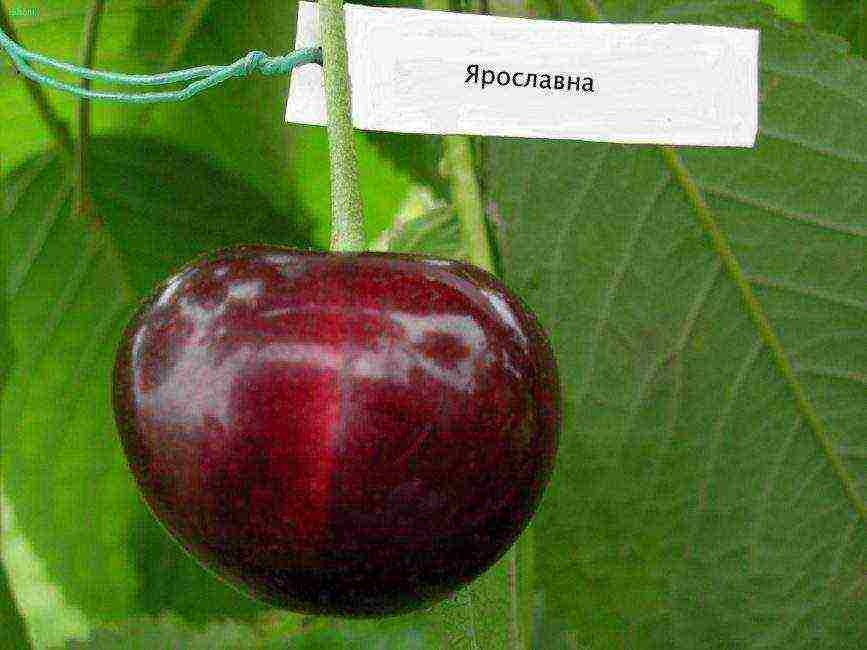
PROS:
- The tree is medium-sized, its height does not exceed 3.5 m
- Does not require special conditions for growing, care
- The yield indicator is high, annual
- Type of separation from the stalk dry
- Taste and marketable qualities are excellent
- Fruit size is large, weight is 8-9 g
- The pulp is very sweet, pleasant, of medium density, red in color
- The color of the cherry pomegranate is red, the stone is small in size, it separates well
- The increased degree of frost resistance, drought resistance, resistance to coccomycosis
- Berries in high humidity conditions do not crack
- Transportability is good
MINUSES:
- The variety is vigorous, the crown is spherical - spreading, the branches are curved
- Additional pollination required
- Average indicator of resistance to fungal infections
Pollinators: Ovstuzhenka, Raditsa, Iput, Chermashnaya, Fatezh.
8.2 Overall Score
After reviewing the description of cherry varieties, having studied their strengths and weaknesses, you can choose the most suitable option for your personal plot. It is recommended to purchase seedlings in specialized retail outlets, while you need to pay attention to the presence of damage on the trunk and root system. We tried to collect for you the most popular varieties of sweet cherries and give all the necessary information on them. If you disagree with these ratings, leave your rating in the comments with the reasoning for your choice. thank you for your participation. Your opinion will be useful to other users.
Add your review | Read reviews and comments
The best cherry varieties are a conditional concept, since in warm regions - in Ukraine, in the south of Russia - more thermophilic plants are common, but residents of the Leningrad region and the Moscow region need to select frost-resistant varieties.
In addition, someone loves sweet, and someone with sourness; some are crispy, some are softer; there are adherents of black cherry varieties, pink, yellow, with a red barrel ... There are a great variety of sweet cherry varieties! How not to get lost among this variety and choose the best cherry variety just for you - we will figure it out in this article.
Cherry varieties: classifications
Classification of cherries by ripening dates
You can provide yourself with sweet juicy fruits for almost the entire summer - from late June to August. To do this, you need to create in your garden a collection of early-ripening cherry varieties (ripen around the end of June), mid-ripening (ripen around mid-July) and late-ripening varieties (ripening period - early August).
Early ripe cherry varieties - Iput, Gronkavaya, Early Rose, Valery Chkalov, Skazka, Chance, Ruby Early, Electra, Ariadna, Chermashnaya;
Mid-season varieties of cherries - Tyutchevka, Leningradskaya rose, Rechitsa, Revna, Fatezh, in memory of Chernyshevsky, Ovstuzhenka, Orlovskaya Rose, Veda, Adeline, Poetry, Pink Pearl, Dniprovka, Dilemma;
Late-ripening cherry varieties - Prestige, Leningradskaya black, Red dense, Bryanskaya Pink, Orion, Romance, Lyubitsa Turovtseva.
Classification of cherries by fruit color
Black (dark red cherry): Veda, Adelina, Tyutchevka, Bryanochka, Revna, Raditsa, Leningradskaya Chornaya, Iput, Gronkavaya, Ariadna, Ovstuzhenka, Rechitsa, Michurinka;
Yellow cherry: Chermashnaya, Drogana yellow, Home garden yellow, Red dense (yellow cherry with a red barrel);
Pink cherries: Leningrad pink, Early pink, Orlov pink, Bryansk pink, Fatezh;
Orange cherries: Pink pearls;
Classification of cherry varieties by taste
Sweet cherries: Michurinskaya, Raditsa, Ovstuzhenka, Tyutchevka, Rechitsa, Leningradskaya black, Chermashnaya, Iput, Gronkavaya, Bryanskaya rosea, Ariadna, Revna;
Sweet cherry with sourness: Early pink, Poetry, Oryol pink, Fatezh, Pink pearls.
Classification of cherries according to the structure of the pulp
Conventionally, according to the density of the pulp, the cherries are divided into two groups - with tender, soft pulp (gini) or dense, crunchy (bigarro).
Gini cherry varieties: Early pink, Orlovskaya pink, Liningradskaya black, Leningradskaya pink, Chermashnaya, Iput;
Bigarro cherry varieties: Michurinka, Poetziya, Fatezh, Rechitsa, Bryanskaya rozovaya, Ariadna.
Description of varieties of sweet cherry with a photo
Description of cherry varieties with photos
Drogan yellow cherry variety
Drogan's cherry yellow
Yellow Drogan yellow cherry is a mid-season frost-resistant variety of the bigarro group. The variety is highly adaptive, it can grow in Belarus, and in the North Caucasus, and in Central Asia. The fruits of the sweet cherry variety Drogana yellow are heart-shaped, weighing 6-7 grams, the pulp is light yellow, the juice is almost transparent.
Features of the Drogan yellow cherry variety: - Drogan's cherry tree, yellow, tall, with a spreading crown. Consider this if the site is small;
- very thin skin of the fruit. On the one hand, it is much more pleasant to eat berries with a delicate skin, on the other hand, such cherries are poorly suited for transportation or freezing, and the fruits can crack on the tree. The bone does not separate from the pulp;
- high productivity. Moreover, all the fruits reach at the same time, do not fall off on their own;
- high drought resistance and frost resistance;
- Drogana Yellow is not a self-pollinated variety, therefore, cherries of other varieties will need to be planted in the garden;
- susceptible to damage to the cherry fly.
Cherry variety Home Garden Yellow
Sweet cherry Home garden yellow
Cherry Priusadebnaya Zheltaya belongs to the early maturing varieties of the bigaro group. The average weight of one berry is 5-6 grams, the pulp and skin are yellow, the pulp is sweet with sourness. This variety is perfect for the conditions of central Russia. Loves black soil.
Features of the sweet cherry variety "Homestead yellow" - self-pollinated variety, that is, it can do without pollinating neighbors;
- begins to bear fruit rather late - in the 6th year (ordinary cherries - in the 4-5th year);
- extremely productive variety;
- despite the fact that the Homestead yellow is an early ripening variety, it is not afraid of frost;
- not susceptible to fungal diseases or cherry fly damage;
- it reproduces very actively, therefore it will cause a lot of trouble with pruning and removing shoots. In addition, the crown of the tree is very lush.
Cherry variety Rechitsa
Cherry Rechitsa
Sweet cherry Rechitsa is a mid-season variety of the bigarro group, sweet in taste, frost-resistant. The weight of the berries reaches 6 grams, the pulp is dark red, the stone is easily separated from the pulp. The tree itself is of medium height. Cherry Rechitsa is relatively unpretentious to the soil, excellent for central Russia.
Features of the Rechitsa variety - berries are not prone to cracking;
- frost-resistant variety, not susceptible to diseases;
- pollinating trees are needed (Adelina, Ovstuzhenka, Pink Pearl);
- not a very prolific variety - one tree will yield no more than 15 kg of cherries.
Cherry variety Leningradskaya Black
Cherry Leningradskaya black
Leningradskaya black belongs to the mid-season varieties of the gini group. The berry tastes sweet, but not large - 3-4 grams, the bone does not separate from the pulp.The height of the tree is up to 3.5 meters.
Features of black Leningradskaya black cherry: - low winter hardiness;
- not capable of self-pollination (it is best to plant in a pair with the varieties Revna, Veda, Tyutchevka, Bryanochka, Iput);
- medium-fertile varieties - up to 20 kg of sweet cherries are harvested from one tree.
Cherry variety Ovstuzhenka
Cherry Ovstuzhenka
Cherry Ovstuzhenka belongs to mid-season varieties, berries weigh 6-7 grams, very juicy and sweet. The variety is suitable for cultivation in the south of the Non-Black Earth Region.
Features of sweet cherries Ovstuzhenka: - berries are not prone to cracking;
- the variety is frost-hardy enough, not susceptible to diseases;
- relatively low yield - no more than 15 kg from one tree;
- not capable of self-pollination (it is recommended to plant in tandem with Tyutchevka, Revna, Raditsa, Iput).
Cherry variety Leningradskaya pink
Sweet cherry Leningradskaya pink is a mid-season variety of the Gini group. The berries are small enough, about 3.5 grams, the pulp is very tender, yellowish, the skin is yellow with a ruddy side. Leningrad pink is suitable for growing in the northwestern and central Non-Black Earth Region.
Features of the Leningradskaya pink variety: - the tree is quite tall with a lush crown;
- not capable of self-pollination (it is recommended to plant in tandem with varieties of memory of Chernyshevsky, Pink Pearl, Rechitsa, Adeline);
- average yield - no more than 15 kg from one tree.
Cherry variety Tyutchevka
Cherry Tyutchevka
Cherry Tyutchevka belongs to mid-season varieties. Berries weighing about 5 grams, the stone is poorly separated from the pulp. The tree is of medium height, extremely resistant to disease and cold. Cherry varieties Tyutchevka are recommended to be grown in the south of the Non-Black Earth Region.
Features of cherry varieties Tyutchevka:
- average yield - up to 15 kg per tree;
- well suited for transportation or freezing;
- not capable of self-pollination (planted together with Ovstuzhenka, Iput, Raditsa).
Cherry varieties Revna
Cherry Revna
Cherry Revna belongs to mid-season varieties. The berry is dark red, almost black in color, weighs 4.5-5 grams, the bone is separated from the pulp well, the pulp is quite dense. The height of the tree is average. Cherry Revna feels good in the south and in the center of the Non-Black Earth Region of the Russian Federation.
Features of cherries Revna - partially self-fertile variety, but for abundant fruiting it is necessary to plant in a pair with Tyutchevka, Iput, Raditsa, Ovstuzhenka;
- winter-hardy variety, not susceptible to diseases;
- excellent for transportation and freezing;
- excellent, abundant fruiting - up to 30 kg of fruits from one tree.
Sweet cherry varieties Iput
Cherry Iput
Cherry Iput belongs to the early ripening varieties of the gini group. The fruit weighs 5-5.4 grams, the sweet pulp is difficult to separate from the stone. A medium-sized tree with a wide crown. Sweet cherry Iput is recommended for cultivation in the south and in the center of the Non-Black Earth Region.
Features of Iput cherry varieties:
- fantastic yield - up to 30 kg of fruits per tree;
- extreme frost resistance - can withstand up to -32 degrees of frost;
- resistant to fungal diseases;
- partially capable of self-pollination. For a regular and good harvest, you need to plant next to the cherries of the varieties Ovstuzhenka, Raditsa, Revna, Bryanskaya pink.
Sweet cherry varieties Fatezh
Cherry Fatezh
Cherry Fatezh belongs to the mid-season varieties of the Bigaro group. The berries weigh about 4.3 grams and are sweet and sour. A medium-sized tree with a spherical crown and beautiful drooping branches. Cherry varieties Fatezh are best grown in the south in the center of the Non-Black Earth Region.
Features of Fatezh cherries - the buds are not very frost-resistant, in contrast to the trunk and branches;
- the yield can reach 30 kg per tree;
- not susceptible to diseases, in particular - rot;
- a self-infertile variety, you should choose Ovstuzhenka, Iput, Raditsa as neighbors.
Sweet cherry varieties Bryansk pink
Sweet cherry Bryansk pink
Sweet cherry Bryanskaya pink refers to late-ripening varieties of the bigarro group. The berry weighs about 5 grams, the pulp is sweet, pink in color, the small stone does not separate from the pulp. Sweet cherry Bryanskaya pink feels good in the central part of the Non-Black Earth Region.
Features of the Bryansk pink variety: - the buds are not resistant to frost, and the trunk and skeletal branches are resistant;
- due to the peculiarities of the crown, the tree practically does not need pruning;
- high yield - up to 30 kg per tree4
- berries are not prone to cracking.
- not capable of self-pollination, Ovstuzhenka, Revna, Tyutchevka, Iput should be planted in the neighborhood.
Of course, this is not a complete list, but we have considered the most popular cherry varieties. We hope that the description of cherry varieties with a photo will help you make the right choice. We remind you: when choosing a cherry variety, be sure to ask whether it is self-fertile or not, and with which cherry varieties it should be planted. Only in this case you will get an excellent harvest of cherries, which we wish you with all our hearts!
Tatiana Kuzmenko, member of the editorial board Sobcor of the Internet edition “AtmAgro. Agroindustrial Bulletin "
If you cannot boast of a large plot, then when choosing a cherry variety for yourself, you should focus not only on its characteristics (yield, fruit weight, taste, resistance to pests and diseases), but also on its self-fertility.
Self-fertility is the ability of trees to bear fruit without cross-pollination with other tree varieties. Self-fertile cherry varieties will have to be selected by those gardeners who own small plots and are not able to place several varieties blooming at the same time on them for mutual cross-pollination. Unfortunately, not so many varieties are capable of self-pollination.
We have selected the top 7 best self-fertile cherry varieties and ranked them in descending order of self-fertility (from the highest to the lowest value of this indicator). All these varieties will surely delight you with a decent harvest, even far from the "sister" trees.
It is important to understand that the yield of inter-pollinated cherry trees will always be higher than that of self-pollinated plants. This is a specific feature of the culture - in order to obtain the maximum yield variety declared in the description, the sweet cherry needs pollinating varieties.
Backyard yellow
This variety is the leader of our top, as it has the highest self-fertility among the known varieties of sweet cherry. Due to the fact that the size of the tree is medium, and the fruits are tasty and fragrant, the Home Garden is always a welcome guest on any, even a small garden plot.
The yellow color of the fruit will add charm and charm to the garden, decorate the table and diversify the gardener's diet. You won't have to wait long for fruits - trees quickly enter fruiting, are characterized by active growth and high resistance to both diseases and pests, as well as to winter frosts, and even spring frosts.
Sweet cherries of this variety will always provide you with a harvest, because its fruits hang on branches without crumbling or cracking even in rainy weather.
| Entering fruiting | Tree height (m) | Fruit weight (g) | Harvest | Pollinating varieties |
| For 5-6 years | 3,5-4,5 | 5,0-5,5 | Early July | Does not need pollinating varieties |
Bereket
This variety has a high self-fertility, however, to increase the yield, one or a couple of pollinator varieties can be planted with it. The variety was obtained at the very beginning of the XXI century, and therefore is characterized by all the characteristics inherent in modern varieties - high winter hardiness and drought resistance, as well as resistance to pests and diseases.
The trees of the Bereket variety are medium in size, they are suitable for any, even the most modest site. Plants quickly bear fruit and produce beautiful dark red fruits with juicy, surprisingly tasty pulp.
The undoubted advantages of the variety include the high transportability of the fruit, and the absence of the need for formative pruning of the tree, which makes it simply ideal for planting in the country.
| Entering fruiting | Tree height (m) | Fruit weight (g) | Harvest | Pollinating varieties |
| For 4-5 years | 4,8-5,3 | 5,6-6,3 | Start - mid June |
Self-fertile, but when pollinated varieties Iput and Revna the harvest increases |
Goryanka
The variety was bred in the last century, but this does not mean that it is morally obsolete. It will give odds to any, even the most modern cultivator, because its trees have restrained growth, resistance to drought and frost, as well as diseases and pests.
The fruits of this variety are quickly tied after flowering and ripen together, turning into elegant maroon "dresses" with a pleasant, juicy and very tasty pulp.
The variety is remarkable in that it gives good yields, even on the site, a single tree is planted. The fruits can be transported over long distances without damage, and the seed in the berries is small and separates very well from the pulp.
The variety is suitable for cultivation in summer cottages and small farms.
|
|
||||
| Entering fruiting | Tree height (m) | Fruit weight (g) | Harvest | Pollinating varieties |
| For 4-5 years | 4,1-4,7 | 6,0-6,4 |
Start - |
Self-fertile, but when pollinated varieties Iput and Revna the harvest increases |
Tyutchevka
A modern cherry variety with a whole complex of useful and necessary signs for any summer resident is both sufficient self-fertility, and the modest size of the tree, and resistance to diseases, pests, frost and drought, as well as early entry into the season of fruiting and, of course, excellent taste and fruit color, which is good in compote, and fresh when they are full of sweet juice.
The fruits have a bizarre wide-rounded shape, a dark red "outfit" pleasant to the eye and surprisingly juicy, tasty red pulp.
The variety can be advised to plant on your site also because its fruits are very pleasant to collect. The thing is that their stalk is thick and rather long, and the berries themselves break away from it easily, almost without effort, and the ripe ones hang on the branches without falling, as if waiting for you.
Due to the fact that the fruits are well transported, you can easily take them from the dacha to the house.
| Entering fruiting | Tree height (m) | Fruit weight (g) | Harvest | Pollinating varieties |
| For 4-5 years | 4,0-4,3 | 5,3-7,4 | End of June - early July |
Self-fertile, but when pollinated by varieties Ovstuzhenka or Raditsa the harvest increases |
Dunn
A rare variety can boast a complete absence of flaws, Dunn is one of them. The trees stand out among others for their luxurious pyramidal crown, which practically does not thicken and requires only sanitary pruning, for its highest resistance to winter frosts and spring frosts, as well as to pests and diseases.
It is worth planting at least one seedling of the Dunn variety on your site, as soon you will get a good harvest of large and aligned, like a ruler, fruits of a pleasant dark red color. And their flesh will be juicy, tender and so pleasant to the taste that you will eat all the berries unnoticed.
| Entering fruiting | Tree height (m) | Fruit weight (g) | Harvest | Pollinating varieties |
| For 4-5 years | 4,0- 4,7 | 4,5-4,9 | Start - mid June |
Self-fertile, but when pollinated varieties Iput and Revna the harvest increases |
Dolores
A variety with a romantic name that will not leave anyone indifferent. It will come in handy for hurry gardeners who are not used to waiting for a long harvest, for those who do not want to use a stepladder to pick every last berry, and for those who wish to see healthy and luxuriantly blooming plants when they come to the dacha or return to the garden in spring.
Those with a sweet tooth will not be disappointed either - Dolores fruits have all the qualities to satisfy the taste of even the most fastidious cherry lover.Each fruit, like a fresh candy, is “packed” in a maroon wrapper and contains a small, almost invisible bone, which is hidden in a juicy, tasty and fragrant burgundy pulp with a piquant sourness, which does not spoil at all, but on the contrary, gives the taste sophistication.
The fruits are suitable for all types of processing, and the trees are suitable for planting in any, even the smallest area.
| Entering fruiting | Tree height (m) | Fruit weight (g) | Harvest | Pollinating varieties |
| For 4-5 years | 3,5-3,8 | 5,5-6,2 | Mid june | Self-fertile, but when pollinated varieties Iput and Revna the harvest increases |
Pridonskaya
This variety closes our top-7. But do not think that he does not have sufficient self-fertility to produce crops, even if you have a single tree growing on your site. It's not like that at all. Despite the partial self-fertility, the Pridonskaya cherry will supply you with a harvest in the form of very large, one-dimensional fruits of a rich bright red color with pink, slightly gristly and very juicy pulp of a pleasant, refreshing sweet and sour taste.
The variety is also valuable because its yield is stable and annual, because the flowers are not afraid of spring frosts, and the plant itself is not afraid of severe frosts and summer heat.
The variety is suitable for growing both in the country and in an average-sized garden, its trees do not require any pruning except sanitary, and no protection, because they do not get sick and are extremely rarely affected by pests.
| Entering fruiting | Tree height (m) | Fruit weight (g) | Harvest | Pollinating varieties |
| For 5-6 years | 3,8-4,5 | 5,0-6,5 | Start - mid June |
Self-fertile, but when pollinated varieties Iput and Revna the harvest increases |
We have considered the most interesting varieties of cherries that deserve the attention of both amateur gardeners and professionals. The listed varieties have all the features inherent in modern varieties and, moreover, are characterized by high self-fertility, which will allow you to grow on the site not only cherries, but also plants of other breeds. Do not forget that planting trees of self-fertile varieties, like other stone fruit crops, is best in spring.

